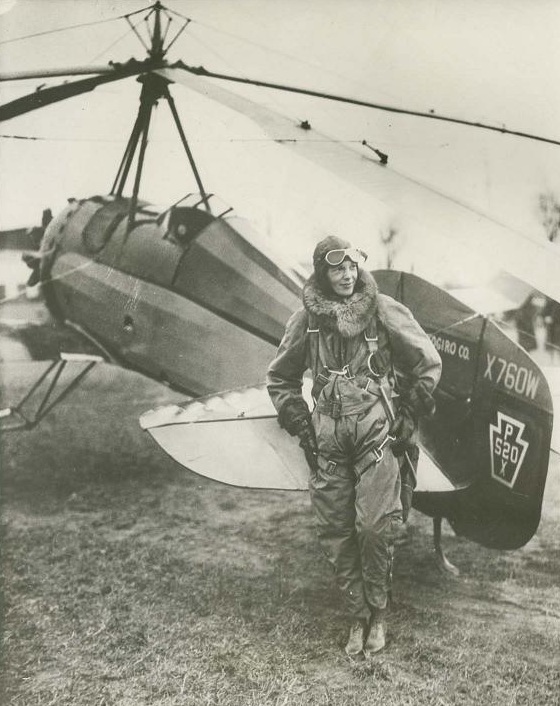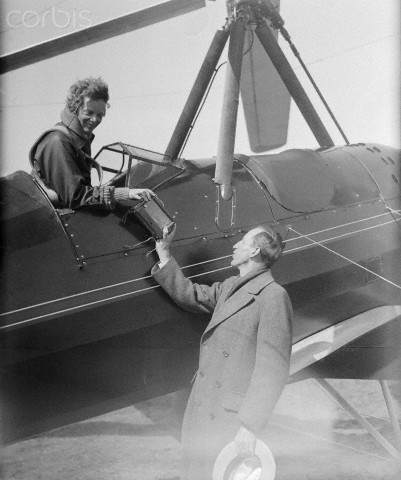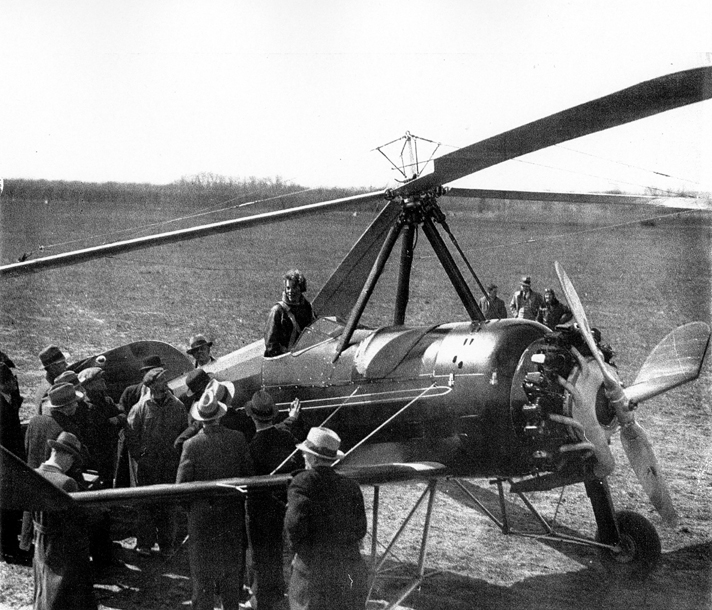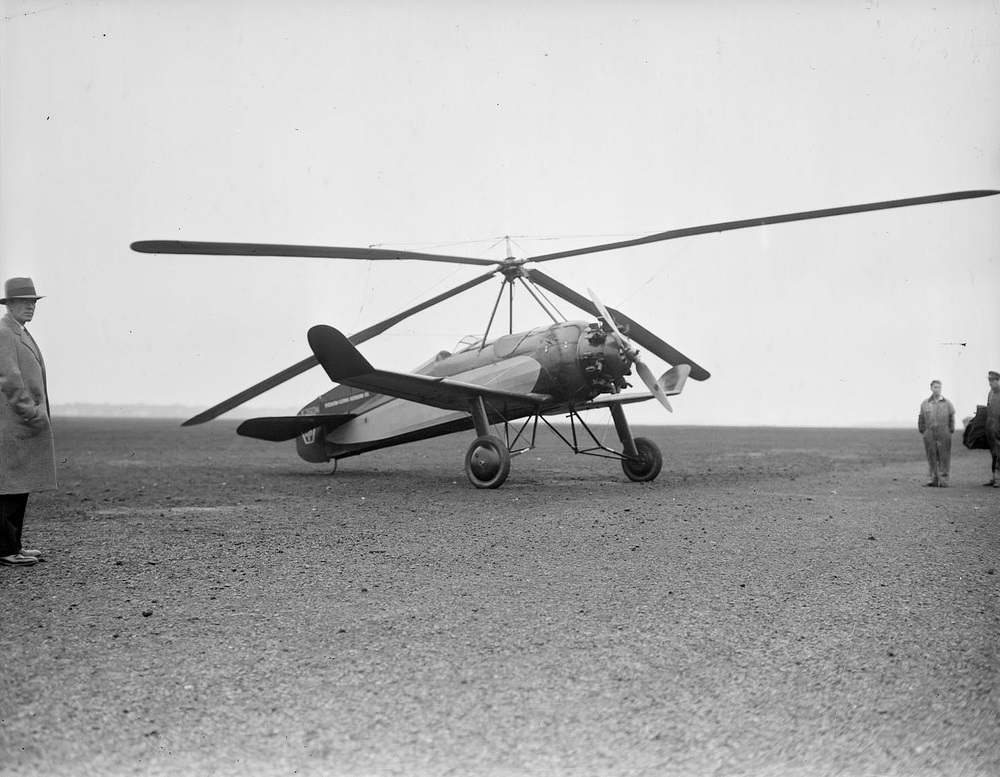

A sealed barograph was carried aboard to record the altitude for an official record. Following the flight, the barograph was sent to the National Aeronautic Association headquarters in Washington, D.C., for certification.

An autogyro is a rotary wing aircraft that derives lift from a turning rotor system which is driven by air flow (autorotation). Unlike a helicopter, thrust is provided by an engine-driven propeller. The engine does not drive the rotor.
The Pitcairn Autogyro Company’s PCA-2 was the first autogyro certified in the United States. Operated by a single pilot, it could carry two passengers. The fuselage was constructed of welded steel tubing, covered with doped fabric and aluminum sheet.

The PCA-2 was 23 feet, 1 inch (7.036 meters) long, excluding the rotor. The low-mounted wing had a span of 30 feet, 0 inches (9.144 meters), and the horizontal stabilizer and elevators had a span of 11 feet, 0 inches. (3.353 meters). The overall height of the autogyro was 13 feet, 7 inches (4.140 meters). The PCA-2 had an empty weight of 2,233 pounds (1,013 kilograms) and gross weight of 3,000 pounds (1,361 kilograms).
The four-bladed rotor was semi-articulated with horizontal and vertical hinges to allow for blade flapping and the lead-lag effects of Coriolis force. Unlike the main rotor of a helicopter, there was no cyclic- or collective-pitch motion. The rotor system was mounted at the top of a pylon and rotated counter-clockwise, as seen from above. (The advancing blade is on the right.) The rotor had a diameter of 45 feet, 0 inches (13.716 meters). The blades were approximately 22 feet (6.7 meters) long, with a maximum chord of 1 foot, 10 inches (0.559 meters). Each blade was constructed with a tubular steel spar with mahogany/birch plywood ribs, a formed plywood leading edge and a stainless steel sheet trailing edge. They were covered with a layer of very thin plywood. A steel cable joined the blades to limit their lead-lag travel.
The aircraft was powered by an air-cooled, supercharged, 971.930-cubic-inch-displacement (15.927 liter) Wright R-975E Whirlwind 330 nine-cylinder radial engine with a compression ratio of 5.1:1. The R-975E produced a maximum 330 horsepower at 2,000 r.p.m. at Sea Level, burning 73-octane gasoline. The engine turned a two-bladed Hamilton Standard variable-pitch propeller through direct drive. The engine weighed 635 pounds (288 kilograms).
The PCA-2 had two fuel tanks with a total capacity of 52 gallons (197 liters). It also had a 6½ gallon (24.6 liter) oil tank to supply the radial engine.
The PCA-2 had a maximum speed of 120 miles per hour (193 kilometers per hour). It had a service ceiling of 15,000 feet (4,572 meters) and a range of 290 miles (467 kilometers).

¹ Most sources state that Earhart set a “world altitude record” on this flight. TDiA checked with the National Aeronautic Association, which certifies aviation records in the United States. NAA has no such record in its files. Fédération Aéronautique Internationale (FAI) records show that Earhart set three world speed records in 1930, and a world distance record in 1932. She is not credited with an altitude record, or any flight record in an autogyro.
© 2019, Bryan R. Swopes
There is a display in the National Air and Space Museum that indicates that she did accomplish that record. And Pitcairn Airfield, though it may have been listed as Warrington at some point, is actually in Horsham, and would later become the Willow Grove Naval Air Station.
Thanks, bobbymo. Several years ago when I was doing the original research for this article, I contacted Mr. A.W. Greenfield, Secretary of the National Aeronautic Association Contest and Records Board and asked him to confirm Earhart’s altitude record. He searched NAA’s files and found no such record.
There could be several reasons for this, including that the documents may have been lost during the intervening 86 years.
The curator of the the Wings of Freedom Aviation Museum at Horsham, Pennsylvania, Mr. David W. Tonkin, is a daily reader of TDiA and we communicate often.
TDiA strives for accuracy. I hesitate to write that someone had established a world or national record if I cannot prove the claim with official documentation.
Thank you. Input from our readers is always welcome.
—Bryan
Hello Bryan,
I continue to be in awe of everything Amelia accomplished.
A few other facts about this Pitcairn:
The wingtips featured considerable dihedral that acted as winglets for added stability, fascinating what aeronautical engineers knew in the day.
The PCA-2 was used in a number of high-profile activities including a landing on the White House lawn and the first flight across the United States in a rotorcraft accomplished by John M Miller who completed his flight nine days before Earhart on 28 March 1931
And I appreciate your work bringing these stories to light. Thank you.
Thank you, Chris. 🙂
Legend, Amelia was a pioneer in every way that matters.
I didn’t read that she used oxygen. Did she have a supplemental oxygen source?
Grey, TDiA didn’t find any information to suggest that she did.